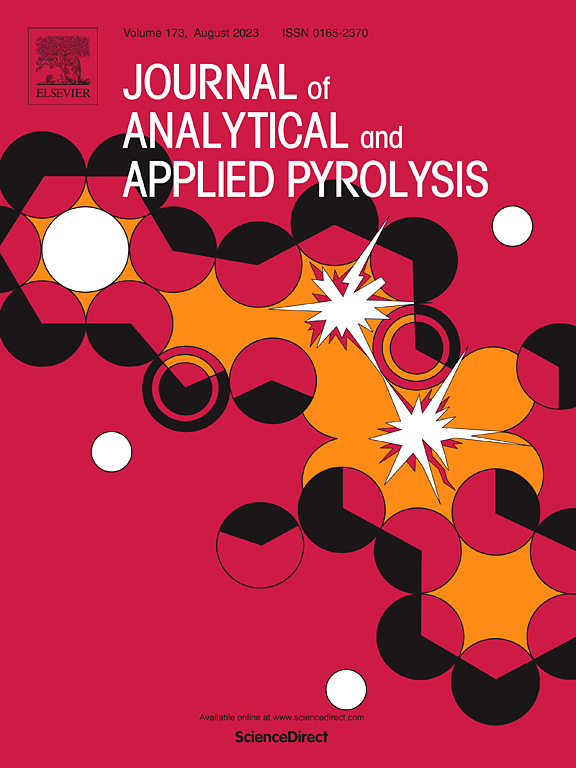Pyrolysis study and surrogate fuel construction of real RP-3 aviation kerosene with SVUV-photoionization molecular-beam mass spectrometry
IF 6.2
2区 化学
Q1 CHEMISTRY, ANALYTICAL
引用次数: 0
Abstract
The pyrolysis of real RP-3 aviation kerosene was studied experimentally in a jet-stirred reactor using synchrotron photoionization and molecular beam mass spectrometry in the range of 700–1050 K. The initial chemical constituents of the RP-3 aviation kerosene were meticulously identified through molecular beam mass spectrometry and gas chromatography. The compositional analysis divided the sample into three principal hydrocarbon groups: long-chain alkanes constituted the predominant fraction at 63.2 %, followed by cycloalkanes at 18.8 %, and aromatic hydrocarbons at 17.2 %. A three-component surrogate fuel was chosen to simulate the pyrolysis characteristics of RP-3 aviation kerosene, comprising 66.2 % n-dodecane (NC12H26), 18.0 % 1,3,5-trimethylcyclohexane (T135MCH), and 15.8 % n-propylbenzene (NPB). A comprehensive kinetic model for the surrogate fuel, involving 462 species and 3199 reactions was developed and validated against experimental data obtained from the pyrolysis of real RP-3 aviation kerosene. Furthermore, the pyrolysis process of the RP-3 was elucidated through a detailed analysis of the production rates of the initial components in the surrogate fuel, which can be classified into three primary reaction pathways. Alkane components undergo alkyl radical chain propagation processes, resulting in the formation of various alkenes. Aromatic components primarily convert into benzene and toluene, while only a small fraction undergoes benzene ring addition reactions to form polycyclic aromatic hydrocarbons (PAHs). Cycloalkanes mainly decompose via unimolecular pathways, generating alkenes, while a smaller proportion undergoes multiple H-abstraction reactions, ultimately transforming into aromatic compounds. Sensitivity analysis indicates that consumption of the fuel components is promoted by H/CH3 radicals at low temperatures. As the temperature rises to 880 K, the insufficient supply of these radicals leads to a competing reaction between the fuel components and the pyrolysis products. The results of the study could contribute to analytical methods for complex mixture fuels and facilitate a comprehensive exploration of jet fuels under combustion conditions.
用紫外光离分子束质谱法研究RP-3航空煤油的热解和替代燃料的构建
利用同步加速器光电离和分子束质谱技术,在700 ~ 1050 K范围内,对RP-3航空煤油在喷射搅拌反应器中的热解过程进行了实验研究。RP-3航空煤油的初始化学成分通过分子束质谱法和气相色谱法进行了细致的鉴定。组分分析将样品划分为3个主要烃类:长链烷烃占主导地位,为63.2 %,其次是环烷烃,为18.8 %,芳烃为17.2 %。采用三组份替代燃料,分别为66.2% %正十二烷(NC12H26)、18.0% % 1,3,5-三甲基环己烷(T135MCH)和15.8% %正丙苯(NPB),模拟RP-3航空煤油的热解特性。建立了包含462种物质和3199种反应的替代燃料综合动力学模型,并根据RP-3航空煤油热解实验数据进行了验证。此外,通过对替代燃料中初始组分产率的详细分析,阐明了RP-3的热解过程,并将其分为三种主要反应途径。烷烃组分经过烷基自由基链传播过程,形成各种烯烃。芳香族成分主要转化为苯和甲苯,只有一小部分发生苯环加成反应生成多环芳烃(PAHs)。环烷烃主要通过单分子途径分解生成烯烃,少部分经过多次吸h反应,最终转化为芳香族化合物。灵敏度分析表明,H/CH3自由基在低温下促进了燃料组分的消耗。当温度上升到880 K时,这些自由基的供应不足导致燃料组分和热解产物之间发生竞争反应。研究结果可为复杂混合燃料的分析方法提供参考,并有助于对喷气燃料在燃烧条件下的综合探索。
本文章由计算机程序翻译,如有差异,请以英文原文为准。
求助全文
约1分钟内获得全文
求助全文
来源期刊
CiteScore
9.10
自引率
11.70%
发文量
340
审稿时长
44 days
期刊介绍:
The Journal of Analytical and Applied Pyrolysis (JAAP) is devoted to the publication of papers dealing with innovative applications of pyrolysis processes, the characterization of products related to pyrolysis reactions, and investigations of reaction mechanism. To be considered by JAAP, a manuscript should present significant progress in these topics. The novelty must be satisfactorily argued in the cover letter. A manuscript with a cover letter to the editor not addressing the novelty is likely to be rejected without review.

 求助内容:
求助内容: 应助结果提醒方式:
应助结果提醒方式:


